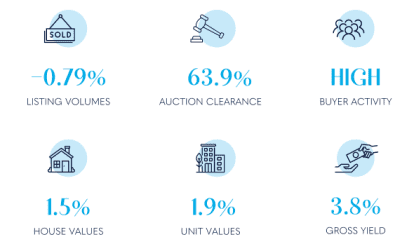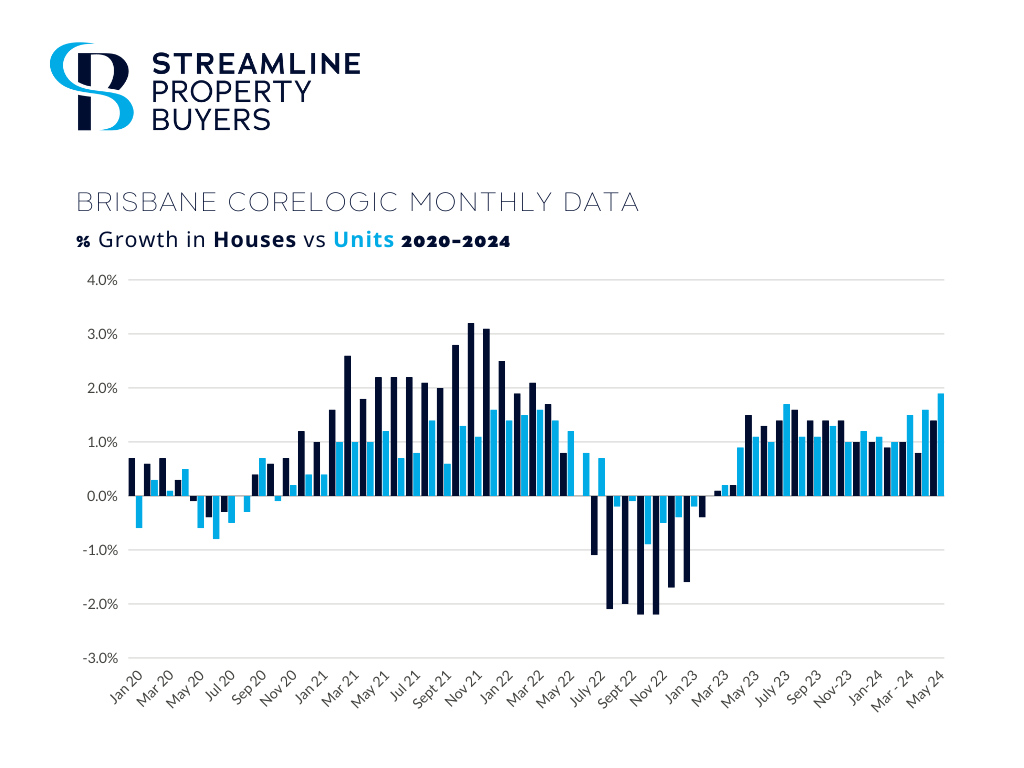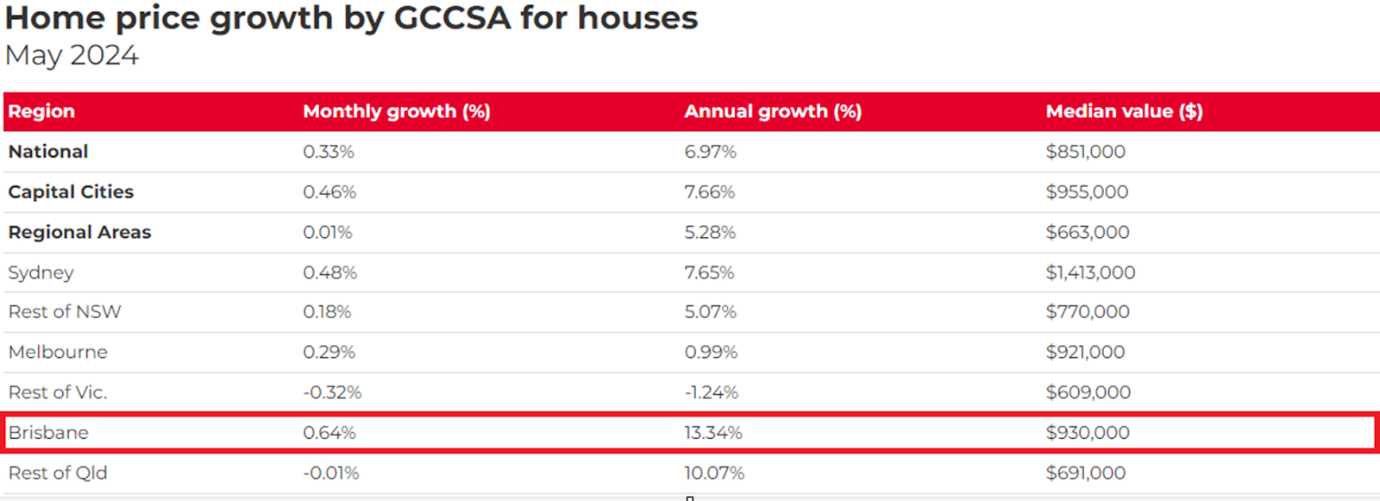Brisbane property market update – May 2024
Throughout May, there was a significant shift in the rankings of Australia’s most expensive capital city markets. Regarding dwelling values, Brisbane surpassed Canberra to now hold the second-highest median values among all capital cities, having overtaken Melbourne earlier this year.

Breaking it down into house and unit markets, we’ve also observed a significant shift in rankings this month.
Brisbane’s house and unit values have demonstrated consistently strong capital growth throughout 2024, while other capital city markets, such as Canberra and Melbourne, have remained relatively stable in terms of median value changes.
In May, Brisbane’s median house values surpassed Melbourne’s for the first time since June 2008, moving Brisbane from fourth to third place among Australia’s most expensive capital city housing markets, now behind Sydney and Canberra. Additionally, Brisbane’s median unit values have overtaken those of both Melbourne and Canberra, making Brisbane the second most expensive capital city unit market throughout Australia.
The primary driver of this shift in Brisbane is the significant reduction in total listing volumes, which are down 34.1 per cent compared to the previous five-year average, according to CoreLogic. Simultaneously, sales volumes have increased by 7 per cent over the last 12 months, indicating strong buyer activity. As a result, any new listings are quickly being absorbed by buyers, continuing to exert upward pressure on prices.
Brisbane has experienced a renewed acceleration in price growth on both a monthly and quarterly basis, with median house and unit values continuing to rise across both market segments. This suggests that Brisbane’s market is not only maintaining its pace but is also gaining momentum in terms of price growth. This marks a significant change from last month when data suggested that the market was decelerating, particularly in the housing sector. Now, it appears that the slowdown in house price growth has reversed.

Brisbane continues to be one of the top three capital city markets for growth on a monthly, quarterly and annual basis, alongside Adelaide and Perth. These markets also exhibit low inventory levels, which likely explains the difference in growth rates compared to other capital city markets across the country.
Throughout May, Brisbane’s auction clearance rate remained steady at 63.9 per cent, consistent with April. The average number of registered bidders per auction, according to Apollo Auctions, increased from 3.1 in April to 3.5 in May, with 62 per cent of registered bidders actively participating by raising a paddle. Despite the rise in registered bidders, the percentage of active bidders remained constant month to month.
Brisbane dwelling values
In May, Brisbane’s dwelling values saw an increase of 1.4 per cent, marking a strong jump from the 0.9 per cent reported in April. Quarterly growth also increased from 3.1 per cent in April to 3.9 per cent by the end of May. The median value for dwellings in Greater Brisbane has now reached a new peak of $843,231, representing an increase of $15,409 from the previous month and $37,638 from three months ago.

Similar to most other capital city markets, Brisbane has witnessed slower growth in upper quartile dwelling values over the past three months. Conversely, the lower quartile has displayed stronger conditions, representing more affordable price points within the market. This trend in Brisbane is further reinforced by the stronger performance changes in unit values compared to house values over the last quarter.

According to PropTrack dwellings data, median values in Brisbane have surpassed Melbourne and are now on par with Canberra. Additionally, Brisbane has maintained its position as one of the strongest performing markets over the past 12 months, with home prices rising by 13.69 per cent compared to a year ago. Interestingly, PropTrack data also indicates that the rate of monthly growth for dwellings in Brisbane has slowed down from the faster pace observed in the first three months of 2024, which is in contrast to the narrative recorded by CoreLogic data.

House prices in Brisbane
In May, median house prices in Brisbane experienced a significant increase of 1.4 per cent, marking a strong uptick compared to the 0.9 per cent growth observed last month. Quarterly growth also saw a shift from 3.1 per cent at the end of April to 3.7 per cent over the three months leading up to the end of May.
Annually, the Brisbane housing market maintains its position as the second-fastest growing capital city market in Australia, trailing behind Perth.
The median value for a house in Greater Brisbane now stands at $937,479, reflecting an increase of $17,433 from last month and $27,491 from three months ago. Over the past 12 months, Brisbane houses have seen a median value increase of $129,307 annually.
In the past month, the median value for a house in Greater Brisbane has just exceeded that of Melbourne. This places Brisbane in third place among the most expensive capital city markets for houses in Australia. Brisbane currently sits behind Canberra, with a median house value of $961,403, and Sydney, which holds the top spot with a median value of $1,441,957.

PropTrack data further validates that Brisbane house prices rose by 0.64 per cent in May, with annual growth standing at 13.34 per cent. Additionally, PropTrack data confirms that Brisbane ranks among the top three capital cities for both monthly and annual house price growth compared to all other capital cities across the country.

Unit prices in Brisbane
Throughout May, unit values in Brisbane saw an acceleration of growth, rising by 1.9 per cent, following a 1.5 per cent increase in April. This brings quarterly growth to 5.3 per cent and annual growth in the unit segment to 18.2 per cent for Brisbane. This confirms that the unit sector of the market remains stronger than the housing sector on a monthly, quarterly and annual basis.
The median value of a unit in Greater Brisbane is now $615,429, which has elevated Brisbane’s ranking in terms of median unit values for capital city markets, surpassing both Melbourne (with a median unit value of $614,299) and Canberra (with a median unit value of $583,587) to become the second most expensive capital city unit market within Australia.
Over the last month, unit values in Brisbane have increased by $15,214 at a median value level, $27,636 over the last quarter, and $94,761 over the last 12 months.

PropTrack data also confirms Brisbane’s median unit values increased 0.86 per cent over the month of May, putting annual growth at 15.74 per cent.

The rental market in Brisbane
Vacancy rates in Brisbane remain critically low, currently sitting at 1 per cent citywide, with several regions throughout the city experiencing even tighter vacancy rates.
The annual change in house rents in Brisbane has increased to 8.2 per cent at the end of May, slightly higher than last month’s 7.9 per cent. Additionally, the annual change in unit rents in Brisbane is now at 9.6 per cent, a slight decrease from last month’s 10.5 per cent. While there is a slowdown in rental growth in the unit segment of the market in Brisbane, there seems to be an uptick in the rate of growth in rents in the housing segment once again.
The rate of rent increase in both the housing and unit markets in Brisbane far exceeds the five-year average before COVID-19, when the national rental index was rising at an average annual pace of just 1.3 per cent. Given this rapid acceleration in rental prices in recent years, it’s understandable that tenants are feeling the affordability pinch.

The gross yield for housing in Greater Brisbane currently stands at 3.6 per cent, unchanged from last month, while the gross yield for a unit has decreased slightly from 5 per cent to 4.9 per cent month-on-month.
Summary
It appears that the current environment with interest rate stability is sustaining buyer and seller confidence. While we’ve seen a slight easing in the rate of population growth, worsening affordability pressures from both a purchasing and rental perspective, higher inflation and low sentiment, the environment in Brisbane with low stock has continued to maintain the imbalance between supply and demand throughout the city.
The only effective way to alleviate pressure is to enhance supply, either by increasing the number of properties listed for sale or by constructing more properties. In 2023, Brisbane witnessed the completion of 2,200 apartments, marking a decrease of 70 per cent compared to the previous 12 months and significantly below long-term trends. Projections indicate a rise in completions over the next 12 months, with 3,100 apartments currently under construction and expected to be completed this year. However, due to the recent low level of commencements, apartment completions are forecasted to decline once again, reaching just 1,200 in 2025. Considering current market conditions and the time required to construct higher-density projects, Brisbane’s apartment market is anticipated to remain severely undersupplied for at least the next two to three years.
Whether it’s detached housing or higher-density developments, the same constraints hinder bringing more supply to the market. These constraints include planning restrictions, inadequate capacity to facilitate essential infrastructure for land development, high taxes and charges, sluggish approval processes, and workforce shortages. Consequently, the new supply pipeline seems distant.
Housing affordability in Brisbane is deteriorating noticeably as median values continue to rise. However, due to the persistent pressure stemming from the considerable disparity between supply and demand, prices are expected to keep climbing in both the housing and unit markets across Brisbane unless there is a significant change in either supply or demand. This ongoing trend will further diminish housing affordability in Brisbane, particularly if interest rates remain elevated for an extended period.
Melinda Jennison, Streamline Property Buyers and president of REBAA.

